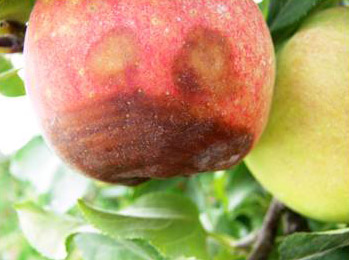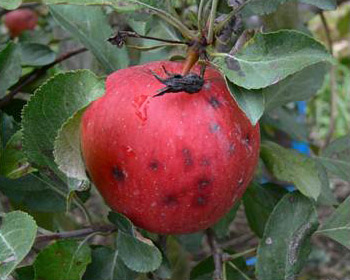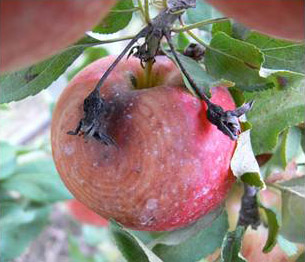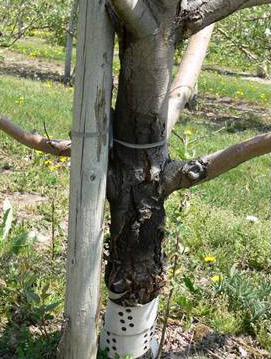Black rot in apples
Learn to identify black rot, caused by the fungus Botryosphaeria obtusa, in apple orchards.
Several apple growers have noticed a higher incidence of black fruit rot on harvested fruit this past season. Black rot is caused by the fungus Botryosphaeria obtusa and appears to be more common in some orchards this year than in previous years. Red specks on sepals are the first symptoms of early infection. Symptoms of this disease sometimes shows up on immature fruit 1–3 weeks after petal fall as red flecks that develop into purplish, slightly raised pimples which often are unnoticed at first or difficult to find. Early sepal or immature fruit infections often develop into blossom end rot which may look similar to those caused by other fungi such as Sclerotinia sclerotiorum or Botrytis cineria. The blossom end rot symptom caused by the black rot fungus will eventually enlarge until the entire fruit becomes rotten as the fruit matures. In contrast, blossom end rots caused by the other fungi remain about the size of a dime at the calyx end (Figure 1). The black rot fungus sometimes proceeds into the core of the apple through the calyx end, causing internal rot. This can occur before external symptoms on the fruit are noticeable and can result in premature fruit drop.

The most common symptom of black rot is the black spots that appear on fruit close to harvest (Figure 2). However, it is hypothesized that the infection of fruit may actually occur much earlier in the season. Spores of the black rot fungus infect through the pores or lenticels of immature fruit and then go to sleep or quiescent without causing much damage. Once the fruit enlarges and as the brix begins to increase closer to harvest, the fungus becomes active again and begins to colonize the tissue around the lenticel. At first the lesions enlarge slowly and appear dark brown or black but as the brix in the fruit increases, the fungus begins to colonize the surrounding fruit tissue more rapidly and the expanding lesions appear dark brown with concentric dark rings (Figure 3). Often a colonized mummified fruit is located in close proximity to the black rot infected fruit which is one source of inoculum for this disease. The bottom line is that infection periods can occur throughout the growing season, however fruit symptoms may not show up until close to harvest. Therefore good fungicide coverage of fruit during the summer is important to keep this disease under control and ensure fruit quality is maintained until harvest. Some varieties such as Gala retain their aborted fruit after chemical thinning, which can become infected with the black rot fungus and become a source of inoculum later in the season.


The black rot fungus can also infect the limbs, scaffolds and the trunks of trees through wounds. Damage to limbs caused by mechanical wounds such as hail or prunning, cankers from other disease, insects or winter injury can provide an entrance for the fungus to invade and become established. Limb cankers first appear as reddish or pinkish, brown sunken areas in the bark. Cankers often remain small and superficial but can sometimes enlarge up to half a meter in length along the infected limb, killing the bark which eventually cracks. It may take 2 years before the fungus colonizes a large area of a limb or trunk. Cankers along the main trunk of trees eventually girdle the tress resulting in premature tree death (Figure 4). The black rot fungus is capable of producing spores for several years on dead wood or infected pruned limbs and branches left on the orchard floor.

The black rot fungus can also infect leaves causing Frog-eye leaf spot. Usually, a mummified fruit can be found within the vicinity of where the patches of frogeye leaf spot symptoms are observed.
There may be several reasons that contributed to the increased incidence of black rot observed in some orchards during 2013. One reason for the higher incidence of black rot in Ontario orchards this year may be due to a reduced summer disease fungicide spray program in 2012. Fungicides applied during the summer to protect fruit probably keep wounds on trees protected which results in less cankers and perhaps less inoculum left in the orchard. Unfortunately the reduced summer fungicide spray program in 2012 may have allowed the fungus to increase inoculum levels in some orchards. Orchards that are in close proximity to wooded areas are often at more risk of infection since the black rot fungus is a weak pathogen of many woody trees and shrubs and contributes to their breakdown in nature. Unfortunately the colonized limbs and branches of trees in these woodlots could be a source of the pathogen for nearby apple orchards. Warm temperatures with frequent rainy and prolonged wet periods experienced this past summer in some apple growing areas was conducive for fruit infection earlier in the growing season.
Management of black rot relies upon good sanitation practices together with a summer disease fungicide program:
- Pruning out diseased limbs and dead wood is an important practice to reduce the inoculum sources within the orchard.
- Remove the prunings from the orchard or burn them since the fungus can survive and produce spores on dead tissue. Alternatively, chopping up the prunings on the orchard floor with a flail mower will also reduce inoculum levels without the hassle of removing them from the orchard.
- Remove mummified fruit to help reduce the potential of the inoculum building up.
- Summer disease fungicide sprays with Captan or Maestro starting as early as silver tip and continued on a 10 to 14 day schedule depending upon weather will protect the fruit from becoming infected and developing black rot.